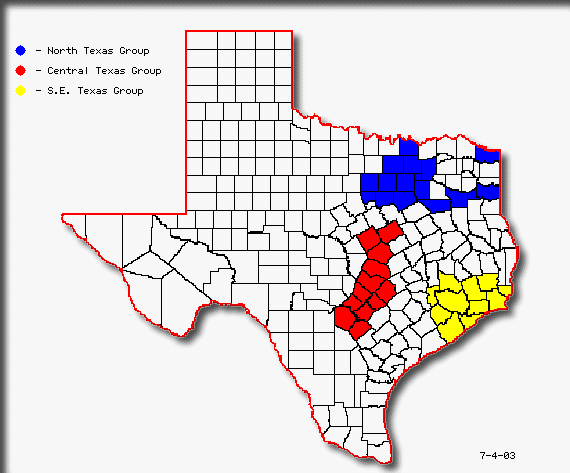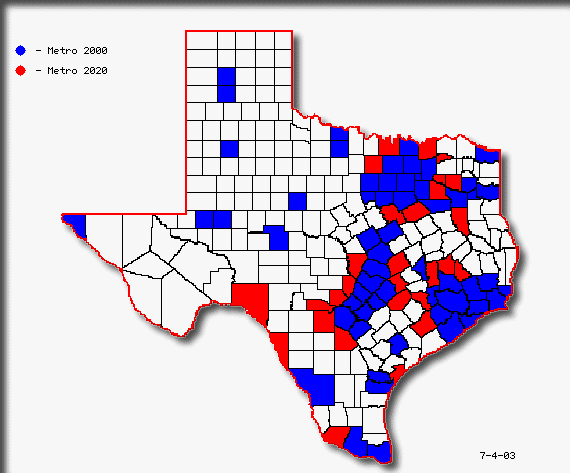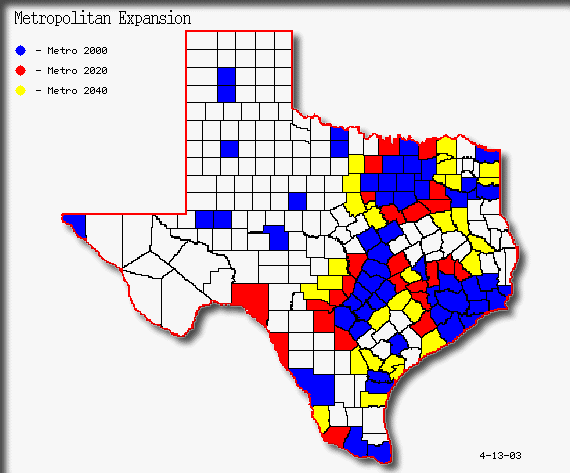
URBAN CONGLOMERATION
The Developing Texas Megalopolis
Conglomeration of urban areas simply refers to them merging together. As metropolitan areas have expanded in Texas we have seen them begin to form what will soon be a Texas megalopolis. An example of this conglomeration can be seen in the merging of the Dallas and Ft. Worth areas. What used to be open grasslands between the two cities twenty years ago is now filled with suburban development. "Texas may one day have a contiguous metropolitan area stretching from Longview-Marshall in the northeast, to Sherman-Denison to the north, to San Antonio on the south, to Beaumont-Port Arthur on the southeast," states Dr. Steve H. Murdock in Tierra Grande.(5) Dr. Murdock calls this developing Texas megalopolis the "Texas Metropolitan Crescent," which is aptly named for its relative physical geographic crescent shape. This developing mega city is of great importance to Texans. This areas will wield political, economic and social power in the coming decades. This expansion of urban areas has yielded three conglomerations thus far. In North Texas, six metropolitan areas have merged. Technically speaking this North Texas conglomeration also includes a seventh metropolitan area in Northwestern Louisiana. The Shreveport-Bossier City, Louisiana MSA is adjacent to both the Longview-Marshall MSA and the Texarkana, TX-AR MSA. Other areas in this North Texas conglomeration are the: Dallas PMSA, Ft.Worth PMSA, Tyler MSA, and the Sherman-Denison MSA. The second conglomeration is located in Central Texas and contains four MSA’s. This conglomeration extends from the Waco MSA on the north end, through the Temple-Killeen MSA, and the Austin-San Marcos MSA, to the San Antonio MSA in the south. The third conglomeration is in Southeastern Texas and contains four metropolitan areas. The third group includes the Houston PMSA, Galveston-Texas City PMSA, the Brazoria PMSA, and the Beaumont-Port Arthur MSA. Figure 3 is a graphic representation of these conglomerated areas. Of particular importance is the distance between each of these conglomerations. Only one county, Hill County, separates the North Texas Group and the Central Texas Group. In two locations, only two counties separate the Central Texas Group and the Southeast Texas Group. As the Texas urban areas expand and these three groups of conglomerations merge, we will see a new Texas Megalopolis form. This area, if it were joined today, would have a population of 14.4 million people. This same area is expected to have 26-28 million residents by 2020, and 32-36 million residents by 2040.(4,6) One issue of concern will be whether or not geographers will accept this area as a true megalopolis. The Oxford Dictionary of Geography defines the term megalopolis as: "Any many-centered, multi-city, urban area of 10 million inhabitants, generally dominated by low-density settlement and complex networks of economic specialization.(7) By definition, Texas will have a megalopolis. However, the term megalopolis was not defined in modern times until 1961, when French geographer Jean Gottmann published his book titled Megalopolis. Gottmann, who studied the Northeastern United States during the 1950s, concluded that the area between Boston and Washington, DC was a continuous interconnected conglomeration of metropolitan areas. These cities were tied together not only by a vast transportation network, but also by economic ties. Gottmann recognized that these cities had a variety of geographic landscapes and were not one continuous urban center, but more of a large functional urban area including suburbs.(8)
Three Current Areas of Urban Conglomeration

Figure 3
(3) Map Composed by Chad Troxell"We must abandon the idea of the city as a tightly settled and organized unit in which people, activities, and riches are crowded into a very small areas clearly separated from its nonurban surroundings. Every city in this region spreads out far and wide around its original nucleus; it grows amidst an irregularly colloidal mixture of rural and suburban landscapes; it melts on broad fronts with other mixtures, of somewhat similar though different texture, belonging to the suburban neighborhoods of other cities,"(8) says Gottmann referring to the Northeastern US. As Gottmann suggests, the influence of an urban center reaches out in a spoke like fashion. In the case of a megalopolis, the spokes of one urban center reach out to a point in which they meet with the spokes of another urban center. This overlapping of influence on surrounding suburban areas is the foundation that forms the connections in a megalopolis. Although the term "Megalopolis" was used to describe the areas from Boston to Washington DC, nicknamed "Boswash," Gottmann also noted several other megalopoli emerging in the United States. These areas are: Chi-Pitts, the areas of urban clustering from Chicago to Pittsburgh, which includes the cities of Chicago, Pittsburgh, Cleveland, Detroit, and Indianapolis. SanSan, another emerging megalopolis, describes the area from San Diego to San Francisco. SanSan includes the greater Los Angeles metropolitan area as well. Another recent developing megalopolis of note is Cascadia, which is the region from Portland, Oregon to Vancouver BC, which includes Seattle.(9) Comparing Texas to these other developing areas, it is acceptable to conclude that Texas does have a developing megalopolis. This development will be seen as the census counts are tallied in 2010-2040.
Projections for Texas 2020
The TSDC projects a total state population of 27.7 million people in Texas by 2020, while the TWDB projects a population of 29 million by 2020. If current trends continue, the Texas Megalopolis should form by the 2020 census. As the metropolitan areas expand further out into what is now rural areas, the landscape of Texas will see the birth of one mega-city. Figure 4 shows a projected outlook of metropolitan counties in Texas by 2020. Those counties in blue represent metro counties as of the 2000 census, and those in red represent counties that most likely will be added to the metropolitan list by 2020.(4,6)
Metropolitan Texas By 2020

Figure 4
(4,6) Map composed by Chad Troxell.Projections for Texas 2040
The TSDC projects a total state population of 35 million by 2040, and the TWDB projects a population of 36.7 million by that same time. As metropolitan areas continue growing outward after the 2020 census, we will continue to see more rural areas becoming suburban centers of activity. Based on this continued movement outward from the central urban core cities, figure 5 shows the predicted metropolitan areas by 2040. Once again, as in figure 4, blue counties represent those areas that were classified as metropolitan in 2000, red counties are those predicted to become metropolitan by 2020 and those in yellow are those predicted to be metropolitan areas by 2040. With such an expansion of population and metropolitan areas, Texas will have to expand its infrastructure dramatically to keep up with population growth. One of the biggest challenges is how to improve transportation in order to efficiently move people and goods across the state.
Metropolitan Texas by 2040

Figure 5
(4,6) Map composed by Chad TroxellHome